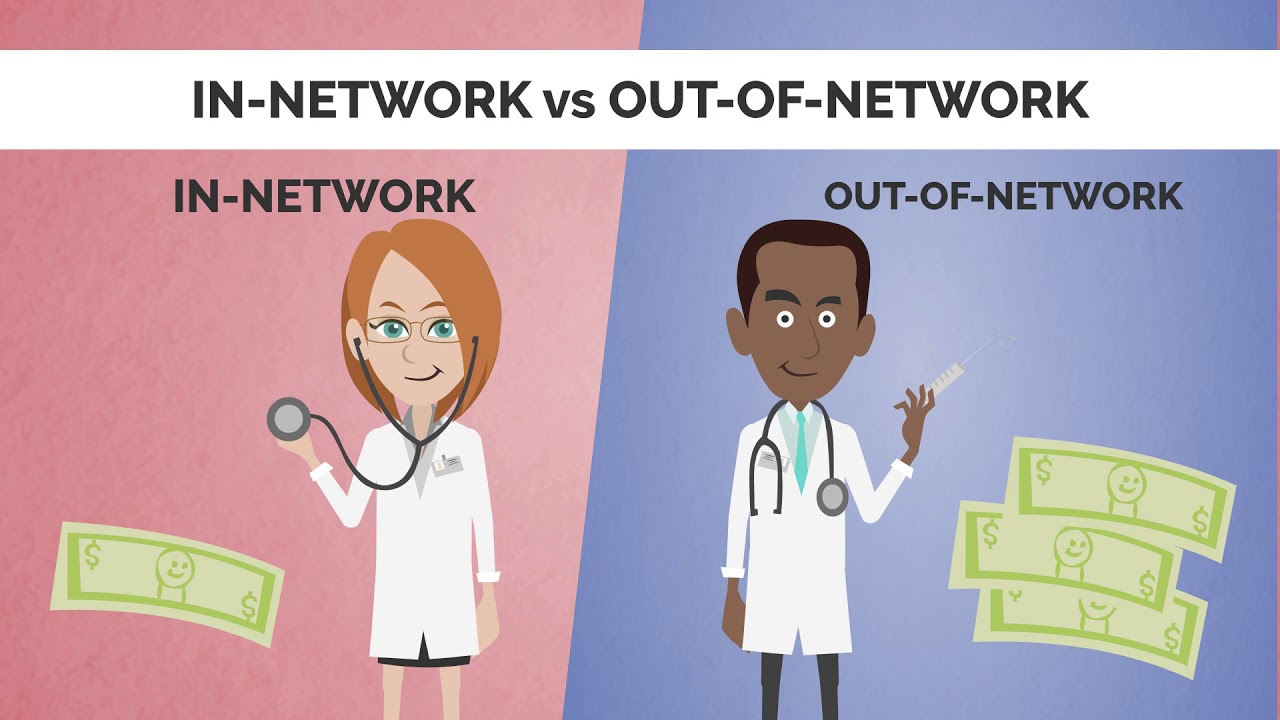health
In‑Network vs Out‑of‑Network: Cut Health Care Costs

Introduction
Health insurance can be a confusing and overwhelming topic, especially when it comes to understanding the difference between in-network and out-of-network health care providers. Choosing the right provider can have a significant impact on your health and finances, so it’s essential to know what each option entails. In this blog post, we’ll explore the differences between in-network and out-of-network providers, their advantages and disadvantages, and how you can make informed decisions that maximize your health insurance options. So let’s dive into this vital topic!
What is an In-Network Provider?

Image by: Yandex.com
When it comes to health insurance, there are two types of providers: in-network and out-of-network. In this section, we’ll focus on what an in-network provider is.
An in-network provider is a healthcare professional or facility that has contracted with your insurance company to provide services at a discounted rate. This means that if you receive care from an in-network provider, you will usually pay less out of pocket than if you go to an out-of-network provider.
Insurance companies negotiate rates with in-network providers to keep costs down for their customers. These negotiated rates can vary from one provider to another and can change over time, so it’s important to check with your insurance company before receiving care.
In addition to cost savings, using an in-network provider often means simpler billing processes as the claims are submitted directly by the healthcare professional or facility. It also ensures that your treatment plan aligns with the guidelines set by your insurance company.
Choosing an in-network provider can be beneficial for both your wallet and peace of mind knowing that you’re receiving quality care within the parameters set by your health insurance policy.
What is an Out-of-Network Provider?
An out-of-network provider is a healthcare professional or facility that does not have a contract with your insurance company. This means that if you choose to receive medical care from an out-of-network provider, you may be responsible for more of the cost of your care than if you had seen an in-network provider.
Out-of-network providers can include doctors, hospitals, labs, and other types of healthcare professionals. When you receive services from these providers, they will bill your insurance company for their services at their own rates. Your insurance company may cover part of these costs but usually only up to a certain limit or percentage.
It’s important to note that some health plans do not cover any out-of-network care except in emergencies. Other health plans may offer some coverage for out-of-network care but at a higher cost-sharing amount compared to in-network care.
Before scheduling an appointment with an out-of-network provider, it’s essential to check with your insurance plan about what expenses are covered and how much it will cost you. Knowing this information beforehand can help avoid unexpected bills and financial stress down the line.
Pros and Cons of Out-of-Network Providers

Image by: Yandex.com
Out-of-network providers can give you more options when it comes to choosing a health care provider. One advantage is that you may be able to get access to specialized services or treatments that your in-network provider cannot offer.
However, out-of-network providers often come with higher costs. You may have to pay more for the same service than you would with an in-network provider because your insurance company will not cover as much of the cost. In some cases, they may not cover any of the expenses at all.
Another downside is that out-of-network providers do not have contracts with your insurance company which means that they are not obligated to follow specific pricing guidelines. This could lead to surprise bills and unexpected charges from certain medical procedures.
It’s important also to note that while some insurance plans allow for limited coverage outside of their network, others don’t provide any benefits whatsoever if you go outside their pre-approved list of doctors and hospitals.
While there are certainly advantages associated with out-of-network providers, these should always be weighed against potential drawbacks such as increased costs and lack of coverage from the insurer before making a decision about where you receive healthcare treatment.
Conclusion
Understanding the difference between in-network and out-of-network providers is crucial to maximizing your health insurance benefits. While in-network providers can offer more affordable care and better coverage, sometimes you may have no choice but to seek services from an out-of-network provider.
When it comes to choosing a healthcare provider, make sure you do your research ahead of time. Check with your insurance company to see which doctors are covered under your plan and what costs will be associated with seeing an out-of-network provider.
Remember that ultimately, the decision is yours. You should choose a healthcare provider based on their qualifications, experience, and compatibility with your medical needs. By staying informed about your options and making educated decisions, you can ensure that you get quality care while also keeping costs down.
health
Healthy Habits, Happy Wallet: How to Save Money While Eating Clean

Eating healthy is important for our well-being, but it can also be expensive. Many people believe that eating clean means breaking the bank, but this doesn’t have to be the case! With a little bit of planning and creativity, you can enjoy nutritious meals without hurting your wallet. In this blog post, we’ll explore some tips and tricks on how to save money while eating clean. So get ready to discover how healthy habits can lead to a happy wallet!
The Cost of Healthy Eating
Eating healthy can be expensive, but it doesn’t have to be. The truth is that the cost of healthy eating varies depending on several factors such as location, seasonality and availability of produce. It’s important to keep in mind that not all healthy foods are created equal when it comes to price.
Processed foods are often cheaper than whole foods because they require less preparation and last longer on the shelf. However, these types of food are usually high in calories, sugar and sodium which can lead to negative health consequences in the long term.
On the other hand, fresh fruits and vegetables may seem more expensive at first glance but they provide essential nutrients that our bodies need to function properly. You don’t need to buy everything organic either – some non-organic produce like avocados or bananas are still considered clean options.
Ultimately, while there might be a higher upfront cost for buying whole foods, investing in your health through clean eating can save you money down the line by preventing chronic disease and improving overall well-being.
How to Eat Clean on a Budget
Eating clean doesn’t have to break the bank. Here are some tips on how to eat healthy without spending a fortune.
Firstly, plan your meals in advance. This will help you avoid impulsive buys and ensure that you only buy what you need. A meal plan can also help prevent food waste, which is not only good for your wallet but also for the environment.
Secondly, opt for unprocessed foods such as fresh fruits and vegetables, whole grains and lean proteins. Processed foods can be more expensive and often contain hidden sugars and additives that are not beneficial to our health.
Thirdly, consider buying in bulk or choosing cheaper cuts of meat. You can freeze any unused portions for later use.
Fourthly, don’t disregard frozen fruits and vegetables – they’re often cheaper than fresh produce but just as nutritious if prepared correctly.
Take advantage of sales or discounts at grocery stores by stocking up on non-perishable items like oats, nuts or canned beans when they’re on sale.
By being mindful with your shopping habits and opting for whole foods over processed ones whenever possible, eating clean on a budget is completely doable!
How to Shop for Healthy Foods
When it comes to eating clean, the first step is to shop for healthy foods. But with so many options available in grocery stores, it can be overwhelming and costly to make the right choices. However, there are ways you can shop smartly and save money while still getting all the nutrients your body needs.
Start by making a list of items you need before heading out to the store. This will help you avoid impulse purchases and stick to your budget. Prioritize fresh fruits and vegetables that are in season as they tend to be less expensive than those that are out of season.
Consider buying generic or store-brand products instead of name brands as they often come at a lower price but contain similar ingredients. Also, check for discounts on bulk purchases which could save you money over time.
When shopping for packaged goods such as cereals or bread, read labels carefully and choose items with fewer additives or artificial ingredients. Look for products labeled “organic” or “non-GMO” if possible.
Try shopping at local farmers’ markets where prices might be lower than in supermarkets because there is no middle man involved in selling produce directly from farm-to-consumer.
By following these tips when shopping for healthy foods, not only will you save money but also ensure that your diet remains nutritious without breaking your bank account!
How to Cook Cleanly on a Budget
Cooking clean doesn’t have to break the bank. Here are some tips on how to cook healthy meals while sticking to a budget.
First, plan your meals in advance. This will help you make a shopping list and avoid impulse purchases. Look for recipes that use affordable ingredients such as lentils, beans, and seasonal vegetables.
Next, buy in bulk whenever possible. Bulk items like rice and oats are often cheaper per serving than pre-packaged versions. You can also buy meat in bulk and freeze it for later use.
When cooking, focus on using whole foods instead of processed or packaged ingredients. Cook from scratch as much as possible to avoid added sugars, preservatives, and other unwanted additives.
Use meal prep techniques to save time throughout the week. Prepare large batches of staples like grains or roasted veggies at the beginning of the week so you can easily mix-and-match them with different proteins throughout the week.
Experiment with herbs and spices instead of relying on pricey sauces or marinades for flavor. A little bit of garlic powder or cumin can go a long way towards making your meals taste delicious without breaking the bank!
Conclusion
Eating clean doesn’t have to break the bank. By being intentional with your food choices and shopping habits, you can eat healthy while staying within your budget. Keep in mind that small changes can make a big impact on both your health and finances. Start by incorporating some of these tips into your routine and see how much money you can save while still enjoying delicious, nutritious meals. Remember, healthy habits lead to a happy wallet!
health
Mental Health Awareness Counseling and Education Services

Introduction
Mental health matters. Just like our bodies, our minds need care and attention. Yet many people do not know where to turn when they feel stressed, anxious, or depressed. Mental health awareness, counseling services, and mental health education can change that. By shining a light on emotional challenges, giving professional support, and teaching coping skills, these services help individuals and communities thrive. In this article, we explore why awareness is vital, how counseling services work, the role of education, and practical steps to access support. If you or someone you know needs help, read on to learn how to take the first step toward better mental health.
The Importance of Mental Health Awareness
Mental health awareness means recognizing signs of emotional distress in ourselves and others. When we talk openly about stress, sadness, and anxiety, we reduce fear and shame. This encourages people to seek help early—before challenges grow into crises.
- Breaking the Stigma: Open conversations show that mental health struggles are common and treatable.
- Early Intervention: Spotting warning signs—like trouble sleeping or loss of interest—can lead to quicker support.
- Community Strength: Awareness events and campaigns create networks of friends, families, and professionals ready to listen.
By making mental health part of everyday talk, we build a culture where seeking help is seen as a sign of strength, not weakness.
Benefits of Counseling Services
Counseling services offer a safe space to share feelings with a trained professional. Counselors guide clients through challenges, teach coping skills, and offer hope.
- Personalized Support: Counselors tailor strategies to each person’s needs, whether coping with grief, stress, or relationship issues.
- Emotional Relief: Simply talking through worries can lift a heavy burden, easing anxiety and improving mood.
- Skill Building: Clients learn tools like mindfulness, problem‑solving, and assertiveness to manage future stress.
- Goal Setting: Counselors help set realistic goals—like improving sleep or building social skills—and track progress.
These benefits combine to boost overall well‑being, resilience, and life satisfaction.
Types of Counseling Offered
Mental health services come in many forms to match different needs:
- Individual Counseling: One‑on‑one sessions that focus on personal history, emotions, and goals.
- Group Counseling: Small groups guided by a counselor where members share experiences and support each other.
- Family Counseling: Sessions with family members to improve communication and resolve conflicts.
- Couples Counseling: For partners seeking to strengthen their relationship and resolve issues.
- Crisis Counseling: Short‑term support for urgent situations, such as after a loss or traumatic event.
Each type provides unique benefits. Individual counseling offers deep personal work, while group sessions foster connection and mutual support.
The Role of Education in Mental Health
Education services teach people about mental health conditions, prevention, and coping strategies. Schools, workplaces, and community centers often offer workshops and seminars.
- School Programs: Lessons on stress management, emotional literacy, and peer support build healthy habits early.
- Workplace Training: Employee programs reduce burnout, promote work‑life balance, and raise awareness of support options.
- Community Workshops: Public seminars on topics like mindfulness, healthy relationships, and coping with grief make resources accessible.
By learning about mental health, participants gain knowledge to help themselves and others, creating a more supportive environment.
Key Services Provided
1. Individual Counseling
- Assessment: Initial interviews to understand background, symptoms, and goals.
- Therapy Sessions: Regular meetings (weekly or biweekly) using methods like cognitive‑behavioral therapy (CBT), talk therapy, or art therapy.
- Progress Tracking: Counselors monitor changes in mood, behavior, and coping skills over time.
2. Group Counseling
- Peer Support: Sharing experiences with others facing similar challenges reduces isolation.
- Skill Workshops: Groups often include activities to practice relaxation, communication, or stress management.
- Community Building: Builds social connections and long‑term friendships among participants.
3. Educational Workshops
- Mental Health 101: Basic facts about common conditions like anxiety and depression.
- Resilience Training: Tools to bounce back from setbacks and maintain a positive mindset.
- Coping Strategy Clinics: Hands‑on practice of techniques such as deep breathing, guided imagery, and time management.
Together, these services form a comprehensive support system for mental health.
How to Access Services
- Contact Your Doctor or School Counselor: They can provide referrals to trusted mental health professionals.
- Search Online Directories: Websites list licensed counselors and local clinics—filter by specialty, insurance, and location.
- Use Employee or Student Assistance Programs: Many workplaces and schools offer free or low‑cost counseling services.
- Check Community Health Centers: Nonprofits and public health departments often provide sliding‑scale or free services.
- Explore Telehealth Options: Online counseling through video or phone can be more convenient and private.
Taking the first step may feel scary, but most counselors are warm and welcoming. You’ll feel relief simply by opening up about your struggles.
The Impact on Individuals and Communities
When more people seek counseling and education, the effects ripple outward:
- Reduced Emergency Visits: Early support prevents crises that lead to hospital stays.
- Improved Academic and Work Performance: People who manage stress well learn and work more effectively.
- Lower Substance Abuse Rates: Counseling teaches healthy coping, reducing reliance on drugs or alcohol.
- Stronger Social Bonds: Education and group sessions build empathy and social skills in families and neighborhoods.
Communities that invest in mental health see happier residents, lower crime, and stronger economic growth.
Tips for Supporting Mental Health
Besides formal services, everyday habits support well‑being:
- Stay Connected: Call a friend or join a group to prevent loneliness.
- Move Your Body: Exercise boosts mood and reduces stress.
- Practice Mindfulness: Spend a few minutes each day focusing on your breath.
- Limit Screen Time: Too much social media can increase anxiety—take regular breaks.
- Set Boundaries: Learn to say no and protect your time for rest and hobbies.
- Get Enough Sleep: Aim for 7–9 hours per night; good sleep supports emotional health.
- Eat Balanced Meals: Nutritious food fuels both body and mind.
Small changes can make a big difference in daily stress levels and overall mood.
The Future of Counseling and Education Services
Mental health support continues to grow and evolve:
- Digital Platforms: Apps and AI chatbots offer 24/7 support and self‑help modules.
- Integrated Care Models: Healthcare systems combine physical and mental health services in one place.
- Community-Based Programs: Local leaders train in mental health first aid to support residents directly.
- Preventive Education: Schools add more mental health literacy into standard curricula.
These trends promise wider access, early intervention, and more personalized care for everyone.
Conclusion
Mental health awareness, counseling services, and education go hand in hand. Awareness breaks down the stigma that holds people back. Counseling offers personalized support and skill‑building. Education spreads knowledge to prevent crises and strengthen communities. Together, these services empower individuals to face challenges, grow resilience, and thrive. If you or someone you know struggles with stress, anxiety, or low mood, remember: help is available. Reach out to a counselor, join a workshop, or talk openly with friends. By taking that first step, you set in motion a path toward better mental health—for yourself and for your community.
Food Drink
Ending Hunger Pangs with the Always Hungry Solution

Introduction
Feeling hungry all the time makes weight loss a constant battle. The Always Hungry Solution promises a way to curb those hunger pangs without starving yourself. By using smart meal timing, balanced nutrients, and easy lifestyle changes, you can manage your weight while still feeling satisfied. In this article, we’ll unveil the core ideas behind this plan, explore its scientific basis, and share actionable tips. You’ll learn how to eat in a way that keeps hunger at bay and moves you toward your goals—no extra snacks required.
Understanding Hunger Pangs
Before diving into the solution, it helps to know why we get hungry so often:
- Blood Sugar Swings: After a high‑carb snack or meal, blood sugar can spike and then crash. This crash triggers hunger signals.
- Hormonal Signals: Ghrelin, the “hunger hormone,” rises before meals and falls after eating. Imbalances can keep it high.
- Empty Stomach: Physical cues from an empty stomach send signals to the brain that it’s time to eat.
- Emotional Eating: Stress, boredom, or habit can trigger cravings even when the body does not need fuel.
The Always Hungry Solution addresses these triggers by balancing blood sugar, managing hunger hormones, and creating healthier eating habits.
What Is the Always Hungry Solution?
Developed by nutrition and medical experts, the Always Hungry Solution is a step‑by‑step plan that focuses on:
- Customized Meal Timing: Eating at specific intervals to keep blood sugar steady.
- Macronutrient Balance: Combining proteins, fats, and carbs in each meal to promote fullness.
- Smart Food Choices: Emphasizing whole foods that digest slowly and release energy over time.
- Lifestyle Strategies: Simple tweaks like mindful eating and stress management to reduce emotional hunger.
Unlike crash diets, this approach teaches how to eat for life. You learn to recognize real hunger, plan meals that satisfy, and avoid the roller‑coaster of cravings.
Scientific Basis of the Plan
Balancing Blood Sugar
Eating protein and healthy fats alongside carbs slows digestion. This produces a gentler rise and fall in blood sugar, cutting down on mid‑meal hunger. Studies show that balanced meals can reduce cravings by up to 50%.
Regulating Ghrelin and Leptin
- Ghrelin signals hunger; leptin signals fullness.
- Diets high in refined sugar and processed foods can disrupt these hormones.
- The solution’s focus on whole foods helps restore normal hormone cycles, so you feel full longer.
Thermic Effect of Food
Proteins have a higher “thermic effect”—your body uses more energy to digest them. By including quality protein in each meal, you slightly boost calorie burn and maintain a sense of fullness.
Core Components of the Always Hungry Solution

Image by: Yandex.com
1. Meal Timing Blocks
The plan divides the day into 6‑8‑hour blocks. Each block has a main meal and a snack or small meal. For example:
| Block | Timing | Meal Example |
|---|---|---|
| Morning | 7 AM–1 PM | Greek yogurt bowl with berries |
| Afternoon | 1 PM–7 PM | Grilled chicken salad + fruit |
| Evening | 7 PM–1 AM | Baked salmon with veggies + nuts |
Spacing meals this way helps balance energy and avoid long fasting periods that spike ghrelin.
2. Macronutrient Pairing
Each meal or snack should include:
- Protein: Eggs, fish, beans, or lean meats.
- Healthy Fats: Avocado, olive oil, nuts, or seeds.
- Complex Carbs: Whole grains, vegetables, or legumes.
This trio slows digestion, keeps blood sugar even, and gives lasting energy.
3. Whole‑Food Focus
Processed foods often lack fiber and nutrients. They digest quickly and lead to crashes. The Always Hungry Solution emphasizes:
- Vegetables & Fruits: High in fiber and water for fullness.
- Ancient Grains & Legumes: Provide sustained energy.
- Lean Proteins & Plant Fats: Support muscle and hormone balance.
Sample Daily Menu
Below is a sample menu showing how to follow the plan in a real day:
- 7 AM (Breakfast): Oatmeal with chia seeds, almond butter, and half a banana
- 10 AM (Snack): Cottage cheese with sliced peaches
- 1 PM (Lunch): Quinoa salad with chickpeas, mixed greens, feta, and olive oil
- 4 PM (Snack): Apple slices with light peanut butter
- 7 PM (Dinner): Grilled turkey burger on a whole‑grain bun with avocado and side salad
- 9 PM (Optional Snack): A handful of almonds or a small Greek yogurt
This menu blends protein, fats, and carbs at every eating window. Hunger should stay moderate rather than overwhelming.
Lifestyle Strategies to Curb Hunger
Mindful Eating
- Slow Down: Chew well and pause between bites.
- Listen to Cues: Eat when truly hungry; stop when 80% full.
- Eliminate Distractions: Avoid screens to focus on food and fullness signals.
Stress Management
Cortisol, the stress hormone, can trigger cravings for sugary or fatty foods. Try:
- Deep Breathing: Five minutes of focused breathing can calm cortisol.
- Short Walks: A quick stroll clears the mind and reduces stress.
- Relaxation Techniques: Gentle yoga or meditation sessions help reset hunger signals.
Hydration
Sometimes thirst feels like hunger. Aim for at least 8 cups of water daily. Herbal teas can also count toward fluid goals and provide a soothing pause between meals.
Benefits of the Always Hungry Solution
- Reduced Cravings: Stabilized blood sugar cuts sudden urges.
- Steady Energy: Balanced meals prevent afternoon slumps.
- Sustainable Weight Loss: No extreme restrictions mean easier long‑term adherence.
- Improved Mood: Less mood swing from sugar crashes.
- Better Sleep: Calmer eating patterns support restful nights.
Users often report losing an average of 1–2 pounds per week without feeling deprived.
Potential Drawbacks and How to Overcome Them
- Initial Planning: Some people find meal timing and prep more work up front.
- Solution: Batch‑cook grains and proteins on weekends.
- Hunger Between Meals: Early days may still bring pangs as hormones adjust.
- Solution: Include a small protein‑rich snack or a cup of herbal tea.
- Social Challenges: Dining out can disrupt timing blocks.
- Solution: Choose restaurants with protein, veggie, and healthy‑fat options; ask for a to‑go box to split your meal.
Real‑World Success Stories
- Sarah, 34: Lost 20 lbs in 3 months by following the meal blocks and swapping soda for water.
- Carlos, 45: Cut his daily snack runs after adding protein‑rich breakfasts. He dropped 15 lbs in 2 months.
- Mia, 27: Reduced stress eating by practicing mindful bites and deep‑breathing before meals.
These stories show how simple changes can yield big results when hunger is managed correctly.
Tips for Long‑Term Success
- Track Your Progress: Note hunger levels, weight changes, and mood daily.
- Adjust as Needed: Tweak meal sizes or timing based on personal hunger cues.
- Stay Flexible: Life events will occasionally disrupt the plan—bounce back quickly.
- Seek Support: Join online groups or find a buddy for accountability.
Consistency, not perfection, drives lasting weight management.
Conclusion
The Always Hungry Solution offers a practical way to end constant hunger pangs and support healthy weight management. By combining balanced macronutrients, strategic meal timing, and simple lifestyle shifts—like mindful eating and stress control—you can keep blood sugar steady and cravings in check. Users report steady weight loss and improved energy without feeling deprived. While initial meal prep and timing may require effort, the long‑term benefits make it worthwhile. Embrace this approach, adapt it to your schedule, and watch hunger fade as you move steadily toward your health goals.
-
Business2 years ago
Cybersecurity Consulting Company SequelNet Provides Critical IT Support Services to Medical Billing Firm, Medical Optimum
-
Business2 years ago
Team Communication Software Transforms Operations at Finance Innovate
-
Business2 years ago
Project Management Tool Transforms Long Island Business
-
Business2 years ago
How Alleviate Poverty Utilized IPPBX’s All-in-One Solution to Transform Lives in New York City
-
health2 years ago
Breast Cancer: The Imperative Role of Mammograms in Screening and Early Detection
-
Sports2 years ago
Unstoppable Collaboration: D.C.’s Citi Open and Silicon Valley Classic Unite to Propel Women’s Tennis to New Heights
-
Art /Entertainment2 years ago
Embracing Renewal: Sizdabedar Celebrations Unite Iranians in New York’s Eisenhower Park
-
Finance2 years ago
The Benefits of Starting a Side Hustle for Financial Freedom

































